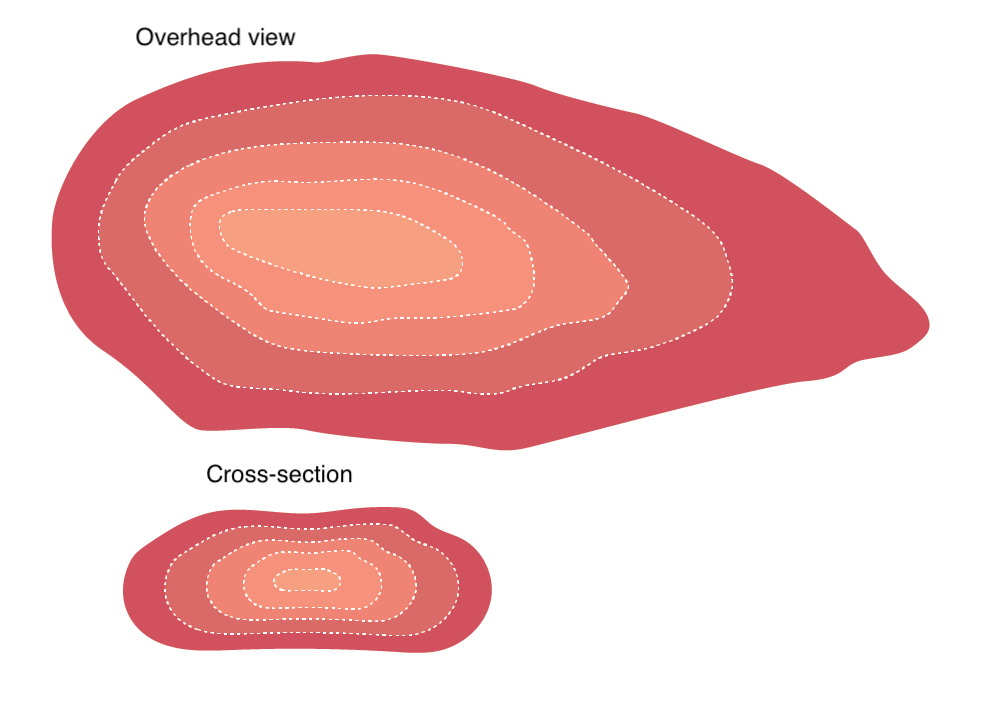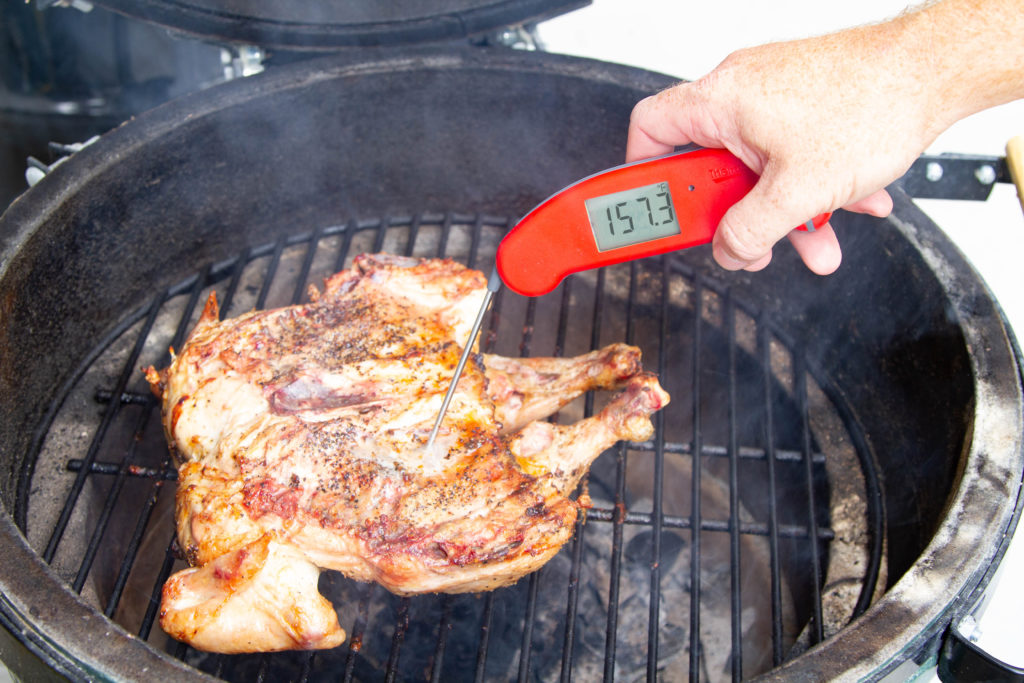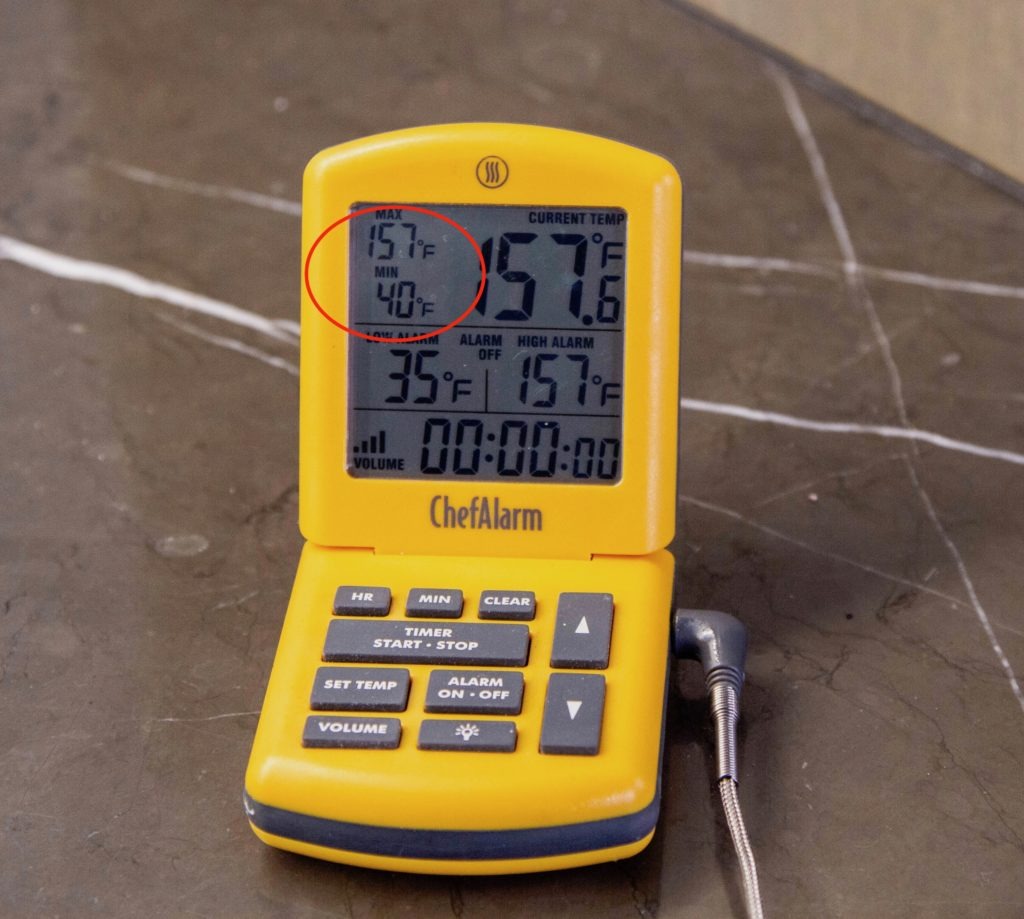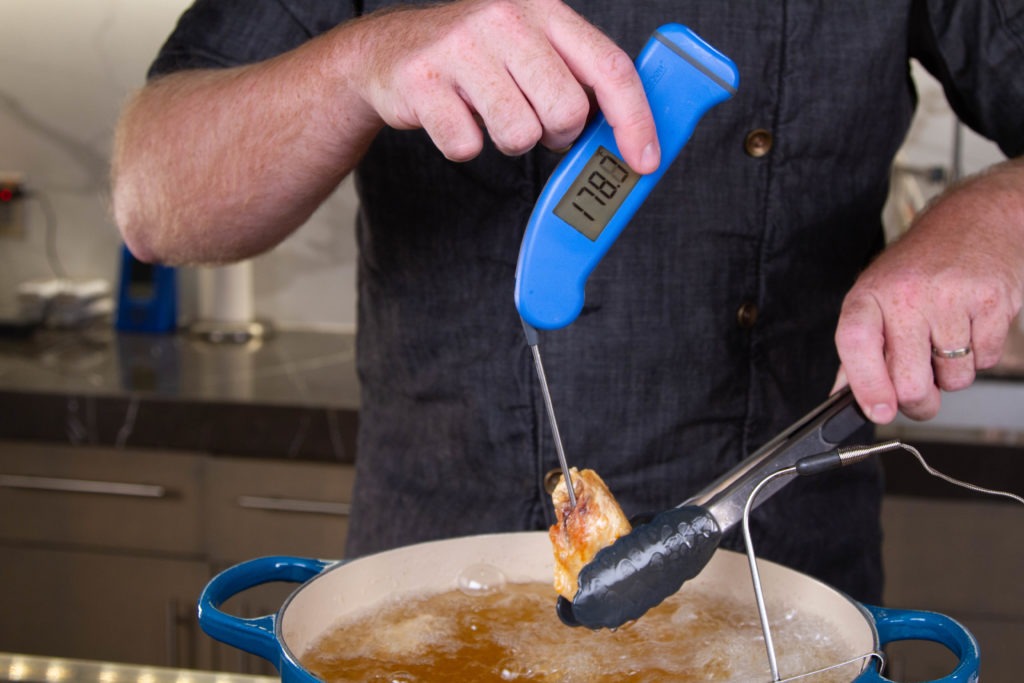Percentage of Salmonella Found in Beef
The number of dinners in America that include chicken is amazing. From freezer meals to BBQ chicken to fried cutlets, from restaurant chefs to college-dorm cooks, chicken is truly one of America's favorite meats.
And yet chicken is too often woefully overcooked. Fearful of contracting a food-borne illness from undercooked poultry, many Americans roast, fry, bake, or grill their craven until information technology is dry, tough, and rubbery. Overcooked chicken doesn't "gustation like chicken" anymore, information technology tastes more similar chalk.
Why is that? Read on to learn!
Cooked chicken temps: safety concerns
All poultry, chicken included, have Salmonella bacteria owned to their bodies—significant that every unmarried craven has some Salmonella in it. The truth is that the chance that in that location is Salmonella in the detail portion of raw chicken y'all are preparing to cook is extremely high.
Of course, you needn't necessarily freak out about that, because Salmonella, but like other harmful bacteria, can easily be killed by cooking food to a high enough temperature.
The USDA publishes critical nutrient condom temperatures for all foods, including chicken, that reflect the oestrus needed to impale the bacteria unremarkably associated with those foods. And near people know that the recommended doneness temperature for food-prophylactic chicken is 165°F (74°C).
The mistake most people make is not bothering to check the actual temperature of their chicken! Instead, they rely on physical indicators of doneness from a pre-technological era. Many people volition cheque their chicken's doneness by checking to encounter if it is firm when pressed, if information technology is no longer pink within, or if the juices run clear when the chicken is cut.
But those methods are seriously flawed! By the time chicken is "business firm," the proteins in the meat volition have squeezed out much of their water, making the chicken dry out. (Every bit the proteins in the chicken chest denature and curl up, and, if they cook far enough, they clasp out the water molecules that cling to them.) The color of meat is also a bad indicator of doneness because pinkness can be caused by non-temperature related factors, such as pH. As for cutting the meat to meet how the juices run, I suppose it could be a good doneness indicator if you want to eat craven that has had its juices literally drained out of it earlier it reaches your plate.
Below we'll comprehend three thermal paths to getting better craven.
Beginner solution: check the chicken temp
The offset—and nearly basic—solution to nether- or over-cooked chicken is to use a thermometer when you melt your craven! (A Thermapen® is ideal for this task, as you'll see presently.) Yes, your grandmother checked it with her thumb, merely she learned to cook before computers were invented! Now we take fast, accurate thermometers that can give us far more than data about our meat'southward doneness than a tactile push button could.
To utilize a thermometer correctly in temping chicken, you lot'll need a thermometer that is fast enough to show the differences in thermal gradients in the chicken.

It goes without saying that a chicken breast cooks from the outside in. As the outermost layer of molecules heats up, they share their heat with the next layer, and those with the side by side, so on down to the coldest spot in the chicken chest, the thermal center. Those differences in temperature make up the thermal gradients.
To take the temperature of your chicken, push the tip of your thermometer's probe through the thickest function of the meat and pull it slowly upward through the meat. Watch the display for the everyman number that it reads: that is the doneness of your chicken. That's why y'all demand a fast thermometer, to read the gradients equally you move the probe through the meat.

By checking actually using a thermometer you tin blast your target temperature without going over. Better chicken is within reach…
Is 165°F really key? Bacterial death is dependent on temperature and fourth dimension
Ok, so most people know about 165°F (74°C), but what near people don't know is that food safety (bacterial dice-off) is a function of both temperature and time. You lot can achieve the exact same bacterial expiry by holding your chicken at lower temperatures for longer times with the verbal aforementioned balls of safety.
The USDA provides guidelines for industry on food safety and uses pasteurization tables to indicate how long it takes to kill plenty bacteria at a given temperature. Below y'all can see 1 such table for medium-lean chicken.
Chicken Safe Temperature Chart
| Temperature | Time to attain bacterial death (in lean white meat) |
|---|---|
| 145°F (62.8°C) | nine.8 minutes |
| 146°F (63.3°C) | 7.9 minutes |
| 147°F (63.9°C) | 6.3 minutes |
| 148°F (64.4°C) | v minutes |
| 149°F (65°C) | iii.nine minutes |
| 150°F (65.vi°C) | iii minutes |
| 151°F (66.ane°C) | 2.ii minutes |
| 152°F (66.seven°C) | 1.7 minutes |
| 153°F (67.two°C) | 1.3 minutes |
| 154°F (67.eight°C) | 1 minute |
| 155°F (68.three°C) | 49.5 seconds |
| 156°F (68.9°C) | 39.2 seconds |
| 157°F (69.4°C) | 31 seconds |
| 158°F (70°C) | 24.5 seconds |
| 159°F (seventy.6°C) | xix.iv seconds |
| 160°F (71.one°C) | 15.3 seconds |
| 161°F (71.7°C) | 12.1 seconds |
| 162°F (72.ii°C) | 9.vi seconds |
(This nautical chart is based on guidelines from the USDA for food manufacturers. You can read the whole article and become expanded charts in PDF version of the certificate beneath.)
Intermediate solution to dry chicken: cook to 157°F and HOLD it
If you want even ameliorate chicken than you get from temping your chicken to 165°F (74°C), employ the pasteurization tables to pick a lower temperature to cook to, and concord your chicken at that temperature for the appropriate amount of time.
(Note: the pasteurization tables vary depending on the fatty content of the meat, though they don't differ much across the fat percentages. Breast meat is very lean, while thigh meat is much fattier. Use the tables accordingly.)
With this method, yous would pick a temperature from the chart, verify that the chicken has reached that temperature as you we discussed above, and hold it at that temperature for the appropriate fourth dimension interval. I actually like 157°F (69.4°C) for my chicken, so I'd concur it at that temperature for 31 seconds.

Y'all tin can use the min/max function on your ChefAlarm® to monitor the temperature and make certain it doesn't dip during your property time. In the in a higher place image, the min temp is 40°F. By pressing and holding the CLEAR button for a few seconds, the min/max will be reset to the electric current temperature. Y'all can hist get-go on the timer and watch information technology for 31 seconds. You lot tin can so check the min temp to see if it dipped below 157°F (69.four°C).

Advanced thermal thinking: carryover cooking in chicken
If y'all're concerned about holding information technology at 157°F (69.4°C) for 31 seconds, you certainly needn't be: carryover cooking volition make sure your meat is condom!
Most people don't realize that when you lot take a chicken breast off of the heat, the residual rut in the outermost layers of the chicken volition cause the internal temperature to keep rising, creating a temperature equilibrium in the whole piece.
This is advanced thermal thinking because information technology requires more than judgment—it entails a dynamic target with two variables: the temperature of the cooking surround and the mass of the meat beingness cooked.
Meat cooked in a hotter environment will have more carryover because there will be more thermal energy in the outer layers that will be pumped into the middle. Hotter cooking ways more carryover cooking: chicken cooked in a smoker at 250°F (121°C) will accept much less carryover than a spatchcocked chicken roasted at 425°F (218°C).
A large piece of chicken, say a whole bird, will have a lot more thermal mass that can move heat into the center, meaning the internal temperature will ascent more than on a modest piece of chicken. A breast experiences less carryover than a whole bird does, and a wing fifty-fifty less.
What that means for yous is that you might set up an even lower doneness temperature on your ChefAlarm when you roast a whole chicken than you would if you were just baking some breasts. Every bit you get used to monitoring temperatures, you will proceeds a sense for how carryover works in various situations and be able to set your alarms meliorate to get exactly the results you lot want.
Dark-meat chicken temps: 175°F (79.4°C)
Everything we've discussed up to this point is focused on cooking chicken breasts. Night meat is a whole other kettle of fish. While dark meat does demand to exist cooked to a prophylactic temperature, information technology must really exist cooked to a higher temperature to be enjoyable. Night meat has much more connective tissue in it, and that tissue needs to be cleaved down to make information technology tender. If you don't like dark meat because of its gummy, rubbery texture, then you lot aren't cooking your dark meat hot plenty! For the connective tissues to break downwardly, dark meat must be cooked to at least 170°F (76.7°C), but it is even better if cooked to 175°F (79.4°C).

But won't that dry the meat out, like in the breast? No. As the connective tissues intermission downwards, they actually release water into the meat, replacing the moisture lost in the initial protein-squeeze. In fact, chicken thighs can attain a consistency much like pulled pork if cooked merely right!
Recap: temp your chicken!
Most people overcook chicken because they utilise concrete artifacts to melt information technology, instead of actually measuring its temperature. The only way to know how well your chicken is cooked is to apply a thermometer, preferably one that is fast (so you know what'south happening now) and accurate (and then you lot know yous're not being lied to by your thermometer).
Though the USDA names 165°F (74°C) equally the doneness temperature for chicken, cooking information technology to a lower temperature and holding it at that temperature for an appropriate time will result in juicier, tastier chicken. Add to ensure safety when cooking to those lower temperatures, rail your chicken's carryover cooking.
By following these guidelines and using a Thermapen® and a leave-in probe thermometer to cook chicken, you'll get meat that is safe, juicy, and tastes meliorate than, well, chicken! Happy cooking!
And now that you know how craven temperatures work, have a await at some of our other posts on chicken:
- Sheet pan chicken
- Baked craven breast
- Delicious fried chicken
- BBQ chicken thighs
- Butterflied whole grilled craven
- Simple roasted chicken
And if you desire to know more about the difference between the ChefAlarm and the Thermapen, you can read upward on which thermometer to utilise.
Shop now for products used in this postal service:
jimenezanchoughboad1955.blogspot.com
Source: https://blog.thermoworks.com/chicken/chicken-internal-temps-everything-you-need-to-know/

0 Response to "Percentage of Salmonella Found in Beef"
Post a Comment